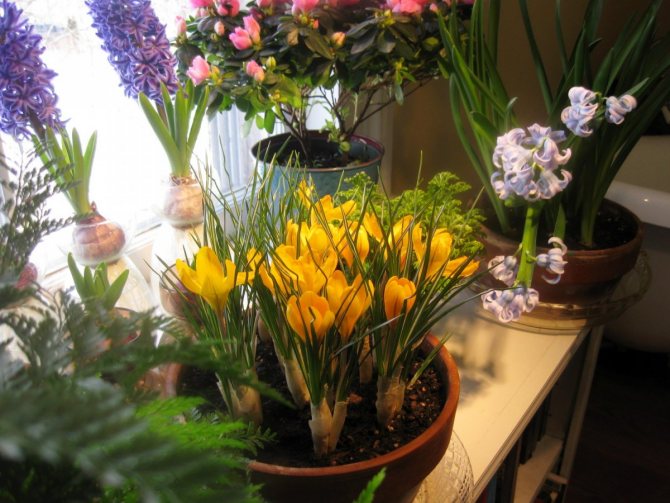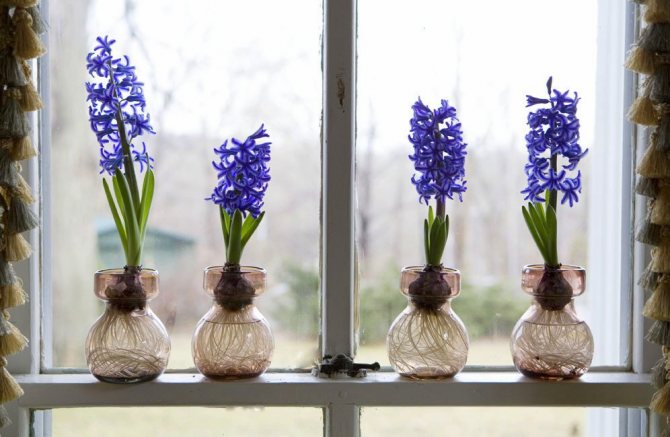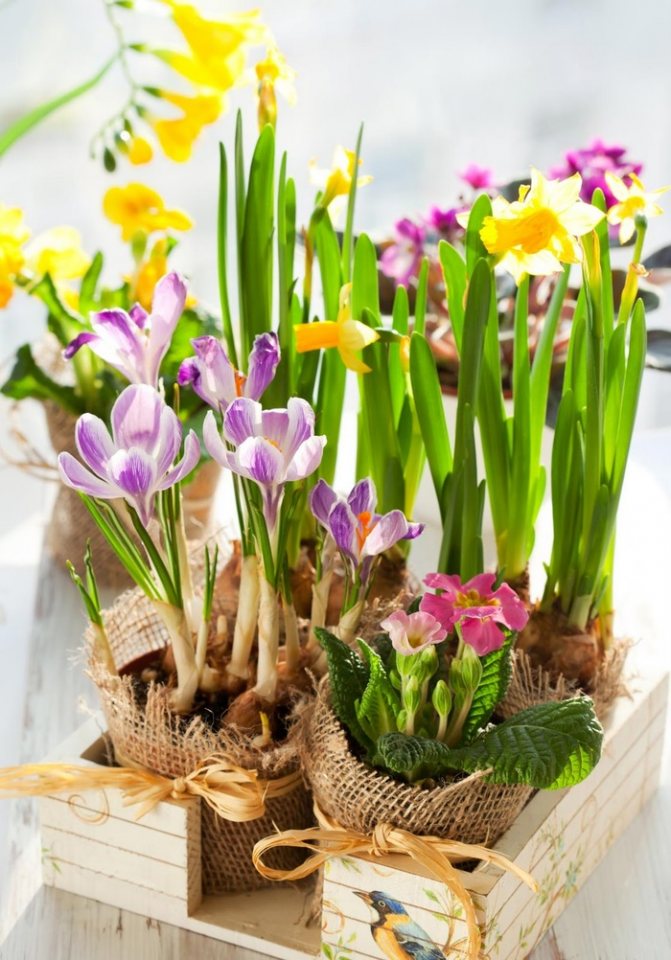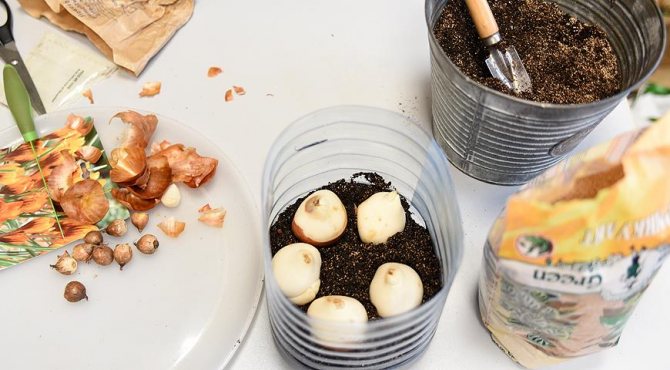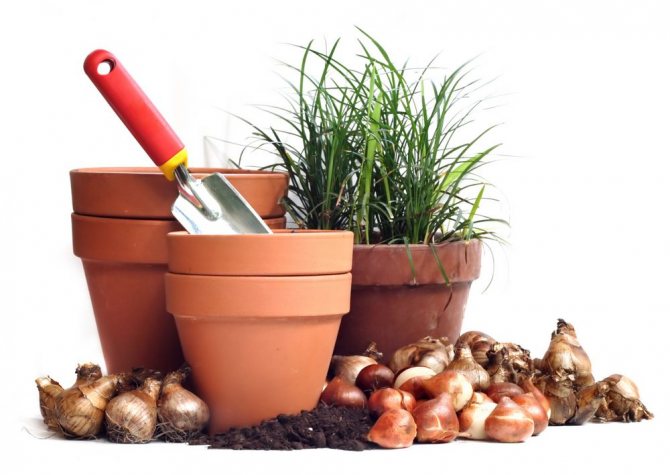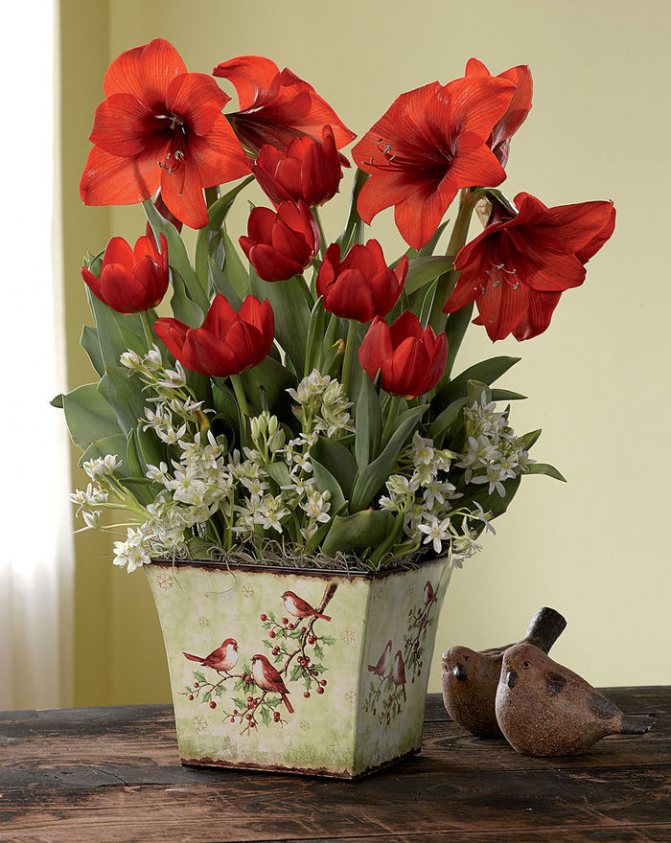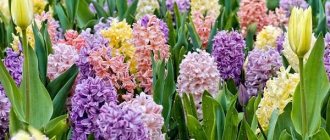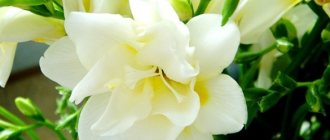What is bulb forcing. When and why to forcing flowers
Bulbous plants can emerge from the dormant period and bloom at any time of the year if the conditions are right for them. The process of awakening and unplanned (non-natural) vegetation with flowering is called "distillation".
In other words, forcing are certain garden techniques that allow bulbous flowers to bloom, for example, for the holidays (by February 14, March 8). The content of the article:
- When is bulb flower forcing carried out?
- How to make a flower bloom in winter. Selecting bulbs for forcing
- How to chase tulips
- How to drive out daffodils
- How to drive out hyacinths
- Forcing crocuses
- Forcing muscari
- Forcing snowdrops
- Forcing lilies of the valley
- Forcing scillas
- Forcing lilies
The first stage is autumn

In nature, this time in the life of bulbous flowers is characterized by an active rooting process. This is how the plant prepares itself for winter and rapid spring growth. Creating the usual conditions for this season, we plant the bulbs in boxes or pots with soil.
At the bottom, it is necessary to arrange drainage, pick up a light and loose soil for planting. Coarse sand, peat or a mixture of these can also be used as a planting substrate.
Bulbous plants intended for forcing are planted quite closely, so they will look much more spectacular. And the nutrients stored in juicy bulbous scales are quite enough for their development. It is only important that the bulbs do not come into contact with each other. The depth of the planting containers can also be small, but in no way less than the height of 2 bulbs.
The bulbs are easily pressed into the moistened and leveled soil and sprinkled on top with a small layer of substrate so that the tops of the bulbs remain open by 1-3 cm.The specific planting time depends on the type of flower chosen for distillation and the expected period of its flowering.
After planting, the boxes or flowerpots are covered with perforated film, thick paper, empty pots or other handy material to maintain constant moisture in them. For winter storage, containers are removed to places where a cool plus temperature in the range of 4-8 degrees will be maintained.
How to make a flower bloom in winter?
How to choose forcing bulbs
Forcing flowers can be done both in apartments and in greenhouses and other rooms where a certain temperature and humidity can be maintained.
It is very important to select large, perfectly healthy, dense and heavy bulbs (lightweight, loose - only weak buds that are not able to bloom can develop).
The bulbs need to be planted in well-washed in disinfected ceramic pots, bowls, sowing boxes: drainage from small pebbles or broken shards is laid on the bottom, a layer of sand of 1-2 cm, and then two-thirds filled with an earthen mixture from sod leaf earth, river sand and peat (4: 2: 1: 1).
The bulbs are laid out so that they do not touch, slightly pressing the bottom into the substrate, after which they are covered with a 2 centimeter layer of sand, watered well and transferred to a cold room (or they are dropped into a greenhouse or trench, covered so that they do not freeze).
The temperature in rooms with bulbs is maintained within 5-9 °. Under these conditions, the rooting and cooling of the bulbs occurs.During rooting, the soil must be moist.
The choice of planting material for forcing
During the development of the plant and flowering, the bulb consumes its nutrients, therefore, completely healthy, dense, undamaged, heavy and large (extra, first analysis) bulbs with outer scales are selected for distillation. Large but lightweight bulbs can only develop weak buds that are unable to bloom during the forcing period. Store the bulbs in a dark, dry place until planting.
Experts recommend that amateur flower growers buy bulbs prepared for forcing in stores and horticultural centers, since it is difficult to maintain the desired temperature at home. Forcing such bulbs is less troublesome and much faster in time.


Own bulbs are prepared for forcing since spring, therefore, when grown in the open field, they strictly observe agricultural techniques for this crop, preventing flowering and are well fed with full mineral fertilizer to lay full-fledged flower buds; the bulbs are dug up in time and stored correctly until forcing. All this serves as a guarantee of their abundant flowering and excellent quality of flowers during further forcing.
As containers, you can use pots with a drainage hole or bowls without holes in the bottom. When forcing bulbs in a garden, it is better to use pots. New pots should be soaked for 2-3 days in water or 12 hours in a weak superphosphate solution to remove any harmful substances left over from the firing. In new clay pots, the roots, especially of hyacinths, can turn black and die off.
How to chase tulips
There are tulip varieties that are most suitable for forcing:
- London,
- Parade,
- Diplomat,
- Appeldoorn,
- Gemagen,
- Pantion.
- Aristocrat,
- Artist.


To get blooming tulips on March 8, large bulbs of the first analysis are selected, weighing at least 30 g with a diameter of at least 3 cm.
Bulbs intended for early forcing (end of December) are kept at a temperature of 9 ° C and planted in early October; for the middle (February) - in the second decade of October; for late - by March 8 (March, April) - stored at a temperature of 23 degrees, and before planting, the temperature is reduced to 17 and then planted (until the end of October).
After planting, the containers are placed in a cold dark room, where at a temperature of 5-9 ° C and moderate watering, the bulbs are stored and cooled. When sprouts 5-7 cm high appear on the surface, forcing can begin. 3 weeks before the scheduled flowering time, tulips are taken out into a warm room, where they are taught to light for 3-4 days at a temperature of 12-14 °, covering them with dark paper in the first days.
After the leaves turn green, the temperature is raised to 18-20 °. At this time, the plants are regularly watered and sprayed with warm water 2-3 times a day, which helps to lengthen the peduncle.
As soon as the plants begin to bloom, the temperature is lowered to 10-12 ° (transferred to a cooler place) in order to prolong the flowering period.
In sunny weather, tulips quickly fade, in cloudy weather, the duration of flowering lengthens.
Early varieties bloom on 18-21 days, late 20-30 after suspension. After flowering, the plants are watered moderately until the leaves wilt. The son-in-law collects, peels and stores the bulbs in the same way as bulbs dug from open ground. In the fall, they are planted in the ground for growing and recovery.
Forcing tulips at home
Tulips are easy to distill, and the most important condition for successful cultivation of these flowers in the middle of winter is well-organized artificial lighting. But first, you need to determine which bulbs are suitable for forcing and which are not.To grow tulips at home in winter, you need extra bulbs with a diameter of 12/12 + (which means 40 mm or more in a circle), the first or second analysis (from 30 to 40 mm in a circle) - the larger the bulb, the larger the flower will be.
The weight of the bulb is also important, as a heavier bulb is a sign that a flower bud is already in it. It happens that small bulbs are heavier than large ones, which are simply overfed with nitrogen. Bulbs weighing less than 25 g are not suitable for forcing.


In terms of flowering time, forcing is early (forcing tulips for the New Year and before Orthodox Christmas), medium (flowering lasts throughout January) and late (flowering from February to March, and sometimes to April). In order to grow tulips by a specific date, you need to know when to start forcing.
Early forcing of tulip bulbs requires planting in late summer or early fall, and forcing on March 8, like medium forcing, requires planting the bulbs during October-November. The following tulip varieties are suitable for early distillation: Epricot Beauty, Brilliant Star, Dixis Favorite, Christmas Marvel, Lustige Battle. For middle: Scarborough, Confux, Apeldoorn and Oxford. For late forcing, timed to coincide with International Women's Day, the following varieties are suitable: Parade, Diplomat, Vivex, London, Keys Nelis and Eric Hofsier.
Forcing hyacinths


Hyacinths are valued for the decorative qualities of flowers and aroma. For forcing, large, at least 5 cm in diameter and weighing 80-90 g, well-ripened, dense bulbs with an intact bottom are used.
To obtain flowering plants for the New Year, hyacinth bulbs are stored in September at a temperature of 23 °. Before planting, which is carried out in October, the temperature is lowered to 17 °.
If flowering is planned for March - early April, the bulbs are stored at 25.5 ° until October, then the temperature is reduced to 17 °. Planting is carried out in the first or second decade of October. The period of cooling and rooting of hyacinths lasts 10-12 weeks at a temperature of 5-9 °.
Two weeks before the planned flowering time, when the height of the sprouts reaches 6-8 cm, the hyacinths are transferred to a room with a temperature of 10-14 ° and gradually taught to light. At the beginning of budding, the plants are placed in a bright place, the temperature is raised to 20-25 ° C.
After the leaves are dry, the bulbs are dug up, dried and stored until autumn planting. Often, after distillation, high quality bulbs are obtained that can be reused.
Distillation for tinting. List of necessary tools for car tinting
It is advisable to prepare the tools that may be needed to complete the task in advance so that everything is at hand and you do not have to be distracted by finding the right squeegee or screwdriver.
List of required tools:
- The knife included by the manufacturer in the kit is most often dulled after the first edge is cut. The best option in this case would be to use a good stationery knife with a replaceable breakaway blade. You should not neglect this advice, since the overall result of the work done depends on how the edges are cut.
- By distillation, air bubbles concentrated between the glass and the tint film are removed. Professionals use several types of such tools, differing both in shape (rectangular, acute-angled, triangular) and in the material from which they are made (plastic, felt, rubber, silicone). It is extremely important not to use for these purposes, products that have burrs on the working surface - this could damage the integrity of the material. When making tinting with your own hands, you can use any object that has an ideal base: a rubber spatula, any plastic card. The only condition in this case is not to use metal objects with sharp edges for distilling air.
- The paper from which the workpiece is made can be quickly fixed on the surface by pressing it with an inner and outer two magnets.
- A scraper with a special handle (shown in the photo) will allow you to clean the glass. Rigid handle - the holder will not allow you to change the angle of inclination of the base, which excludes the possibility of scratches. For these purposes, an ordinary household window cleaner is quite suitable.
- A good old plastic bottle with a spray cap can be used as a spray. It will ensure an even distribution of the liquid on the surfaces to be treated. This method can be used for tinting at home, professionals use a special container connected to a compressor that creates pressure that squeezes out the soap solution.
- Keys, screwdrivers and other tools may be needed to remove the glass. If this is not done, the result will not look good, since the corners of the glass, under the sealing rubber, are difficult to close neatly.
- A hair dryer is used to dry the surface. For side processing, an ordinary home is quite suitable. Application on convex surfaces (most often these are rear windows) requires heating and stretching the film, which cannot be done with it. In this case, you will need industrial or construction.
- A rope or harness will come in handy when reinstalling your windshield or rear window. Without it, this process will be problematic.
Forcing crocuses
Crocus varieties for forcing:
- Peter Pan,
- Joan of Arc,
- Nigroboy
- Queen of Blue,
- Remmorans,
- Yellow Mammuth.
Large bulbs of the first analysis are selected, as a rule, three-, four-year old, and stored for 10-12 days at a temperature of 20-23 °. In October, they are planted to a depth of 2-3 cm, 7-15 pieces each in containers filled with a mixture of sod and leafy soil, peat, sand (1: 1: 0.5: 0.5), covered with a layer of sand or peat in 3-4 cm, watered and put in the basement.


In December - early January, they are transferred to a moderately cool place (12-16 °) and watered. When flower buds appear in January - February, pots and bowls are transferred to a sunny windowsill.
Spraying works very well on sprouting tubers. In cool rooms, crocuses bloom for 13-15 days. After distillation, the tubers are planted in the open ground in the spring.
Forcing snowdrops
In autumn, large bulbs are selected and planted in 5-10 pieces in a small pots or 25-30 pieces in large bowls with nutritious soil to a depth of 3-4 cm. The containers are kept in a moderately moist state at a temperature of 3-5 ° C.
For early flowering, they are brought into a cool room in November. Distillation is carried out at a temperature of 10-14 ° C. Watering is moderate, by the end of the flowering period it is somewhat reduced.
After the leaves die off, the bulbs are taken from containers and stored in a cool place until autumn, and then planted in the ground. [/ Paragraph]
Snowdrop bulbs are not suitable for re-forcing.
Forcing daffodils at home
Daffodil bulbs can be ready for flowering within two months. Planting material, if you do not grow daffodils in your garden, can be purchased at flower shops on the eve of planting - large bulbs specially prepared for forcing. In addition to the already indicated species, the most suitable for growing at home are daffodil daffodils - Geranium White, Lawrence Koster, Scarlett Jam.


For forcing bulbs must be single-peaked, healthy, weighing more than 60 g, and at least 4 cm in diameter. The bulbs are stored at 17 ºC until forcing. Before planting, they are kept for about half an hour in a solution of potassium permanganate of medium strength. You can do with the bulbs of daffodils in the same way as with the bulbs of hyacinths: before planting in the ground, place them in a tray with a root-forming solution and keep them in the vegetable compartment of the refrigerator so that the roots of the bulbs have roots, or you can immediately plant them in a pot with a substrate.
Forcing lilies of the valley
For distillation, a three-year-old lily of the valley plant with a well-formed, large, blunt-pointed bud is selected. The sprouts selected for distillation are knitted into bunches, the roots are cut, dropped into the sand in an upright position and stored at + 2 ° C.
In order for the lilies of the valley to bloom at the end of December, forcing begins at the end of November, and since it is considered early, the sprouts are frozen for two weeks at a temperature of minus 2-3 ° C or, before forcing, they are given a warm bath of 30-35 ° C for 12- 15 hours.
Later forcing in January does not require any preliminary preparation. Lily of the valley sprouts are covered with peat or light earth. When they reach 5-7 cm, they are exposed to the light. [
The main mistakes made when forcing
- Use for forcing bulbs that have not gone through a dormant period at low temperatures: As a rule, ordinary bulbs are purchased in December-January, which have been at room temperature since digging.
Note! If the bulbs have passed all the stages of development, then the packages will contain information about this: the mark “for distillation”.
- The use of varieties (especially important for tulips) that do not withstand forcing.
- Use of land from the garden.
- Reduction of the rooting period, as a result of which the flower uses only the supply of the bulb, the development of the root system slows down, the flowering period is shortened, and the flowers themselves turn out to be pale and frail.
- Insufficient watering in the last month before flowering.
Forcing scillas


Dense small Scylla bulbs are dug up in the fall after the aerial part dies off, stored in a cool dry room; in September-October, they are planted in small bowls, pots and baskets of 5-15 pieces and stored in a cool room until January. Then watered and kept in the dark.
With the beginning of growth, bowls with plants are exposed to the light, flowering soon begins. Faded Scyllas are removed and stored in a frost-free room, occasionally watering until the leaves die off. Stored in pots until autumn to be transplanted into open ground in the fall.
Forcing lilies
Royal, Long-flowered lilies are suitable for forcing. Unlike other bulbous plants, lilies do not need much preparation.


In October, one three-, four-year-old, well-ripened large heavy bulb is planted in the middle of a pot, 13-15 cm in diameter) with a nutrient mixture from turf soil, humus and sand (1: 1: 0.5), watered well and set in basement or greenhouses (with a temperature of 4-6 ° C, periodically and moderately watered).
At the end of December, the plants are brought into the room, where the temperature is gradually increased and by the beginning of flowering it is brought to 15-16 °.
The irrigation regime requires special attention, it is necessary to avoid waterlogging of the soil in the pot, as this leads to rotting of the bulbs.
Once a decade, the plants are fed with a mullein solution. As soon as the buds begin to stain, feeding is stopped, the temperature is raised to 20 ° C. Flowering occurs in 3-3.5 months (March-April) after the start of forcing and lasts 20-24 days.
Used bulbs are planted in the ground for growing.
Video: Forcing bulbous
When forcing tulips, daffodils, hyacinths, lilies are used for cutting, while crocuses, scillas, muscarne, which have a shorter stem, look better in flower pots.
All perennials blooming in spring are also easily distilled: aquilegia, anemones, astilbe, dicentra, iris, forget-me-not and many others. It is quite possible to drive out a number of perennial plants (peony, forsythia, lilac, jasmine, spirea, clematis, deytion) in ordinary room conditions, not to mention the possibilities of greenhouses and greenhouses.



